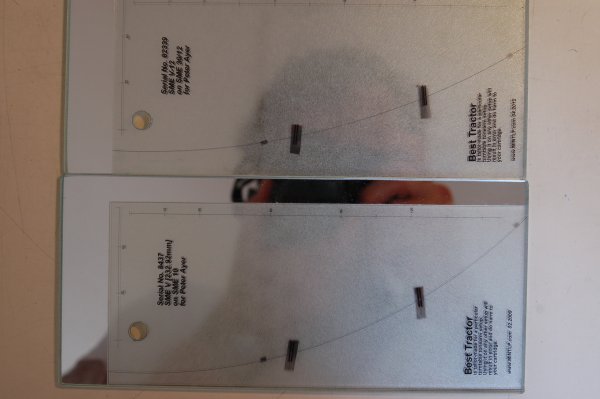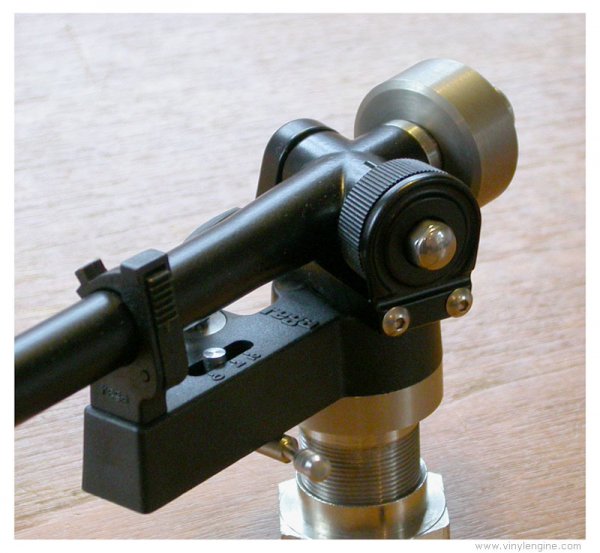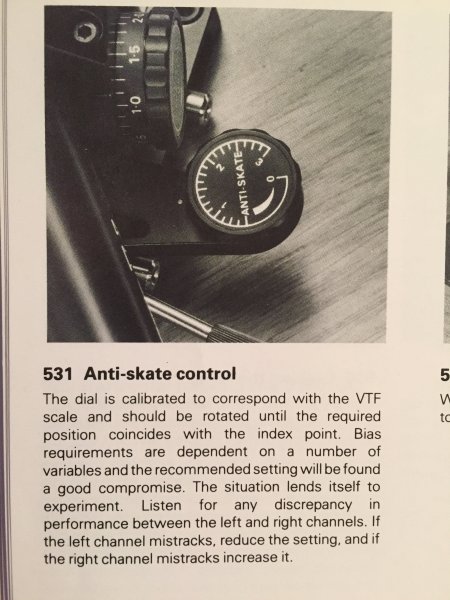Sliding force???
- Thread starter ack
- Start date
You are using an out of date browser. It may not display this or other websites correctly.
You should upgrade or use an alternative browser.
You should upgrade or use an alternative browser.
These are two MINT LP protractors for my 12" and 9" SME V arms. Note the shape of the two traces. The 12" is at top. Note also the horizontal tracking distance or offset (distance from spindle). The longer the arm, the gentler the curve. This is also why SME claims the tracking distortion is 27% less with the longer arm. I understand the stylus trace is different from the cartridge offset angle, but this is to illustrate that when the arm is longer, the trace is flatter, and the offset angle is less, creating less skating force.


Just found this too, quite informative, from Soundsmith's Peter L - He believes in some AS adjustment, but not by a test record.
https://www.sound-smith.com/faq/how-do-i-adjust-anti-skating-my-cartridge
Jadis, thanks for this link. It is excellent.
The only way to figure out what the anti-skate force is would be to somehow measure it, and I am trying to find a way to do it. But as Lederman/Schoeder say, the amount of this force needed would depend on VTF. Therefore, SME's approach of setting anti-skate as a percentage of VTF appears to be correct. Beautiful arms!
I agree. I also think the damped spring in the SME AS mechanism in their newer arms also varies the force during the length of the record side, which I think is consistent with the varying skating force. The string/weight mechanism of the SME 3012R also seems to vary the force as the arm swings inward.
Having just watched Lederman's video, I plan to do the same test that you did on the deadwax portion of an LP to see the results.
Thanks. I've always liked longer arms, and I always loved SME's
Not everyone agrees that longer arms are better, nor is there universal love for SMEs, but I know what you mean.
I agree. I also think the damped spring in the SME AS mechanism in their newer arms also varies the force during the length of the record side, which I think is consistent with the varying skating force. The string/weight mechanism of the SME 3012R also seems to vary the force as the arm swings inward.
Having just watched Lederman's video, I plan to do the same test that you did on the deadwax portion of an LP to see the results.
Great stuff in the SME arms. I am actually beginning to realize that the VPI anti-skating device - that V shape thing - is also varying anti-skate by virtue of its V shape as it rotates, based on where the right-hand leg falls relative to a logical vertical line, and it seems to me that it decreases the force from start to finish of the LP.
Great stuff in the SME arms. I am actually beginning to realize that the VPI anti-skating device - that V shape thing - is also varying anti-skate by virtue of its V shape as it rotates, based on where the right-hand leg falls relative to a logical vertical line, and it seems to me that it decreases the force from start to finish of the LP.
So I just did the test on the deadwax on both 33.33 and 45 records. Near 1.0 grams, the arm is more or less motionless. Above 1.0 g, the arm moves out away from the spindle. At zero AS, the arm moves in slightly faster than the lead in groove. At about 0.5g, give or take 0.25 gram, the arm moves in just faster or slower than the lead out grooves. It is now set at about 0.5 g setting on the calibrated dial. I can get it so that the stylus stays between the lead out grooves and never hit them. The SME spring mechanism is very precise with continuous, not stepped, adjustability.
Looking at the V-12 and 3012R both again, it seems the damped spring mechanism of the newer arm does apply varying amount of AS because of the spring action increasing or decreasing tension with arm movement, while the thread/pulley/weight mechanism of the older arm applies a constant AS force (aside from any friction at the line/pulley contact point due to changing angels of the thread to the pulley and the weight of the line inself being on one side of the pulley for gravity). Otherwise, it is just a simple weight being pulled down due to gravity. I have not installed the 3012R yet as I'm weighting for an armboard to be manufactured.
Thanks Peter. I had no doubt the V-12 would be a better arm in this regard than the 3012R. Keeping the arm motionless in the dead wax is probably not a good setting to select.
Yes I agree. What I mean is I can get that arm to go in towards the spindle at the same rate as the lead out groove goes in so that the arm stays on the dead wax between the leading groove as it moves towards the spindle This seems like a fairly good slow rate of movement towards the spindle, but as I wrote just moving the dial Controls the arm quite well. Incidentally the dial is on the fly so I can adjust it while the record is playing.
So I am wondering if the length of the arm plays a role here. Lederman/Schroeder say it's this headshell offset angle that creates this sliding force - not sure I agree entirely, because if the platter and LP are not entirely flat then they would also affect it - and under that assumption, would/could the arm's length make this force smaller or larger. Not sure, just throwing a question and idea out there.
My Linn Akito 3B arm is 9". I believe the 10" would be called the long arm.
Jadis, thanks for this link. It is excellent.
My pleasure, Peter. Glad to share. Am and still learning a lot, thanks too for your inputs.
My Linn Akito 3B arm is 9". I believe the 10" would be called the long arm.
Yes, it did look like a 9-er. I still do suspect this has to do with your skating behavior.
I am wondering what the inside mechanism of the dial type AS is for SME, and my Linn Akito, now that we have seen clearly how the VPI AS gadget works. Where does the spring apply the 'push pressure' in the tonearm? If there is physical contact to the arm wand, isn't there going to be a compromise there on the integrity of the arm ? Also, the dial of my Akito is quite stiff to make the rotation, and it is a 'smooth' and not click step type of thing. It's almost like I can feel the spring's tension as the dial goes up, specially past the 1.0 mark. The Rega RB300, on the other hand, is not a circular dial, but an straight one, it's like a flat sliding switch, and it is very smooth as it is moved to a certain level. I heard the Phantom and some Clearaudio arms use magnets to create a repelling force, but I'm not too sure. Btw, my old Rega arm was also 9", but has a different behavior re its AS adjustment. I believe my setting was at 1.0, at the middle, tracking the Koetsu Rosewood Signature then at 1.80g.


Last edited:
Here is the entry from my V-12 manual. Pretty basic advice.
The dial is hard to turn because it is filled with I think silicone to dampen the spring coil. I don't know where the end of the spring attaches. Nor do I remember where I read that the AS dial is calibrated to be 2/3 of the VTF value. The manual does state that proper AS depends on a number of factors. Offset angle (arm length), groove modulation, VTF, stylus location on record, etc. Any setting you choose will be a compromise. I had matched the two dials as recommended in the manual, but the Schoder/Lederman deadwax test gives me different results. Both settings sound good but slightly different. I don't hear any clear distortion either way. Listening to a variety of LPs will be the final test for me.
For reference, the deadwax test setting has the dial at the letter A or about 0.5g. I don't understand the graphic symbol between 0 and "Anti".

The dial is hard to turn because it is filled with I think silicone to dampen the spring coil. I don't know where the end of the spring attaches. Nor do I remember where I read that the AS dial is calibrated to be 2/3 of the VTF value. The manual does state that proper AS depends on a number of factors. Offset angle (arm length), groove modulation, VTF, stylus location on record, etc. Any setting you choose will be a compromise. I had matched the two dials as recommended in the manual, but the Schoder/Lederman deadwax test gives me different results. Both settings sound good but slightly different. I don't hear any clear distortion either way. Listening to a variety of LPs will be the final test for me.
For reference, the deadwax test setting has the dial at the letter A or about 0.5g. I don't understand the graphic symbol between 0 and "Anti".

As far as I see these methods are equivalent to setting bias for optimum tracking with a groove with 30-40% modulation. The nominal 0 dB Reference Level is 5cm/s , but is this level the 100% modulation? According to "Information and Measurement" by J.C.G Lesurf most cartridges will track at levels 20 dB above the reference level.
As far as I see these methods are equivalent to setting bias for optimum tracking with a groove with 30-40% modulation. The nominal 0 dB Reference Level is 5cm/s , but is this level the 100% modulation? According to "Information and Measurement" by J.C.G Lesurf most cartridges will track at levels 20 dB above the reference level.
Great question. I think one has to test by listening to a variety of favorite music. It seems inexact at best, but a good method to achieve a useful compromise. If it fails during extreme cases, readjustment may be necessary.
For me, my primary concern now is 1. No distortion heard in any tracks in my favorite records, start to finish. And 2. Straight down tracking of the cantilever when viewed from its front body while playing. VTF is already a given and I always set it at the minimum recommended force rather than the max. Seeing a cantilever bending inwards slightly is a cause of concern to me. And it is a good thing I noticed it early than late or too late. So far, I have heard 'better' results with AS OFF, and that is with real music LPs, not test records. I'm hearing more details than before, and the overall sound is much more transparent and there is more space and air between the instruments. Amazingly, it sounds more balanced, from left to right channels.
Great question. I think one has to test by listening to a variety of favorite music. It seems inexact at best, but a good method to achieve a useful compromise. If it fails during extreme cases, readjustment may be necessary.
I suppose there may be such a thing as inaudible distortion, but I haven't heard it yet. :->
I am pro-active wrt overhang, alignment, VTF and SRA. I am re-active when it comes to anti-skate. My default is none. Only if I hear distortion largely in one channel do I consider changing that.
Similar threads
- Replies
- 129
- Views
- 35K
- Replies
- 14
- Views
- 5K
- Replies
- 1
- Views
- 3K
- Replies
- 107
- Views
- 35K
| Steve Williams Site Founder | Site Owner | Administrator | Ron Resnick Site Owner | Administrator | Julian (The Fixer) Website Build | Marketing Managersing |






